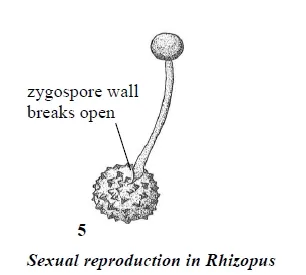Understanding Rhizopus: Structure, Functions, and Life Processes
Objectives
Structure and Life Processes of Rhizopus (Bread Mold)
Kingdom: Fungi
Phylum: Zygomycota
Rhizopus is a genus of common fungi, which includes species such as Rhizopus stolonifer, known for causing bread mold. These fungi play important roles in decomposition and nutrient cycling and have applications in industrial processes. Here, we explore the structure and life processes of Rhizopus.
Habitat of Rhizopus
Structure of Rhizopus
Rhizopus is eukaryotic, multinucleated and non-photosynthetic organism.
The body is made of fine thread-like structures called hyphae (singular: hypha).
The hyphae branch into a complicated network known as the mycelium.
The cell wall of the hypha consists of chitin (complex protein and carbohydrates).
The hypha contains a thin layer of cytoplasm which is multinucleated (several nuclei). The center of the tube of hypha is occupied by vacuole. Hyphae lack cross walls or septa, and therefore described as non-septate or aseptate.
There are three types of specialized hyphae:
a. Stolons: are unbranched hyphae, which grow horizontally on the substrate.
b. Rhizoids: are root-like structures. They anchor the fungus into its substrate, release digestive enzymes, and absorb nutrients for the fungus.
c. Sporangiophores: are the upright hyphae which bear round reproductive structures called sporangia (singular: sporangium)
Life Processes of Rhizopus
Nutrition in Rhizopus
The mode of nutrition is saprophytic or saprotrophic, meaning is not capable of synthesizing its own food and it depend on dead and decaying organic matter. The rhizoids secrete hydrolytic enzymes onto food substrate to break down complex molecules into simpler and soluble substances. The end products are absorbed into the body by diffusion. This method of digestion is described as extracellular digestion.
Growth
Rhizopus grows by hyphal elongation and branching. The mycelium expands rapidly, covering the substrate and maximizing nutrient absorption.
Respiration
Rhizopus performs aerobic respiration, utilizing oxygen to break down organic molecules and release energy for cellular activities.
Decomposition:
As a decomposer, Rhizopus plays a crucial role in breaking down organic matter, recycling nutrients, and maintaining ecosystem balance.
Pathogenicity
Some species of Rhizopus can be pathogenic, causing diseases in plants, animals, and humans. For example, Rhizopus oryzae is known to cause mucormycosis, a serious fungal infection in humans.
- Read about Mucormycosis on the CDC website.
Reproduction in Rhizopus
Rhizopus is able to reproduce both asexually and sexually (conjugation)
1. Asexual reproduction: it occurs when environmental conditions are favorable. The sporangiospores or spores are produced inside a spherical structure called sporangium. Sporangium absorb water from atmosphere, swell and burst to release or liberate the spores. The spores are dispersed by wind and can grow into new mycelia when settle on suitable substrate (such as damp bread).
- Learn more about Asexual Reproduction in Fungi on PubMed Central
2, Conjugation: It involves opposite mating (positive and negative) strains coming into contact. These strains grow towards each other and meet by developing protrusion called progametangia (singular: progametangium). The tips of the progametangia swells and develops into gametangia. The gametangia become separated from the rest of the hyphae by forming a cross wall called suspensor. The walls between the two touching gametangium dissolve allowing the two multinucleate protoplasts to mix. The nuclei fuse in pairs forming several diploid nuclei and later develop into a zygospore. A black thick-walled, forms around the zygospore. The zygospore can withstand adverse conditions. The wall of the zygospore cracks and produces a young hypha with sporangium containing spores.
- Explore more about Sexual Reproduction in Fungi on PubMed Central.
Adaptation
1. Rhizoids for anchorage and nutrients absorption.
2. Sporangiophore which support sporangium.
3. Spores or sporangiospores for asexual reproduction and colonizing new habitat.
4. Sporangium which supports and protect the spores.
Conclusion
Rhizopus is a fascinating genus of fungi with a distinctive structure and diverse life processes. Its hyphae, mycelium, stolons, rhizoids, sporangiophores, and sporangia all contribute to its ability to reproduce, grow, and decompose organic matter. Understanding the structure and life processes of Rhizopus provides valuable insights into its ecological roles and industrial applications.
For further reading, visit Asexual Reproduction in Fungi and Sexual Reproduction in Fungi on PubMed Central.



